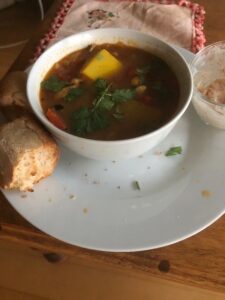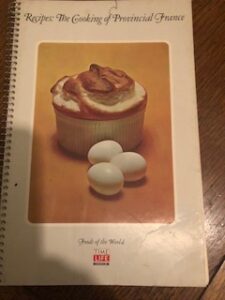I don’t even know how this happened. But I guess that’s true of any obsession–one day you’re just making your way through the tasks presented by the real world and than suddenly there you are. Obsessed. Focused so cleanly on something that everything else falls to the back of your mind like a dull murmur, like the sound of adults in a Charlie Brown special. You know.
So there I was, searching for Brazilian and Portuguese cookbooks that could help me maybe recreate my mother’s food. I found a used volume on Amazon, purchased it for six dollars and voila. When the book arrived I discovered it was part of an old series published by Time-Life in the 1960s and ’70s. On the cover was a large rustic, somewhat batter pan of paella. Just that. Not even a title. I was smitten from the start.

The writing was so lyrical that I forced my husband to listen to paragraphs. And then, lest he grow bored, I fed him Caldo Verde soup which I made following one of the recipes. (It’s mostly potatoes and greens with a onions and a little sausage mixed in. I used a vegan sausage.) The book said that peasants ate this soup on cold nights near the rough Atlantic Sea. We ate the soup on a night where the rain poured down over California and the snow levels fell below 3000 feet.

Do you know this series of books? I remember them in some tiny far away corner of my mind. We never had them in our house–my mother rarely used cookbooks and she would never have subscribed to a series. She didn’t embrace domesticity or food in that particular way. But I had a friend whose mother ordered the books. And then later, when I was in college there was an older woman in one of my seminars who invited the whole class over to her 1920s Moorish home in Santa Monica Canyon. There was one whole room there set up as a bar, and in the big copper-toned kitchen, on shelves installed over an expensively rough hewn sort of picnic style table and benches, I saw the entire collection of the Time-Life Foods of the World Series. This I understood was sophistication.

A few years later, married to my first husband (who I met and wed and divorced when we were still all very young), seeking both solace and a similar sophistication I purchased three volumes of the set. (We weren’t good at paying our bills and I think the series, which was already going out of print, stopped for me because of a payment failure.) I have a very vague memory of making Lion’s Head Meatballs from the Chinese volume and also some other dish which involved wrapping bread around meat and cheese and baking it and making a sort of large and crispy sandwich. I don’t remember from what country this latter dish emerged. And after that I never thought of the books again.
Until now. When I am obsessed. Reading these books is rather like sitting in the sun in the backyard dreaming of travel, combined with binge watching poor sweet Anthony Bourdain on his journeys, and then switching and watching Stanley Tucci in Italy, while simultaneously suffering the fevered affects of the second Covid vaccination, happily or at least hopefully delusional.
To buy all of the volumes as a single collection would be expensive. There are a total of 54 books–half of them spiral recipe folders and half of them hardbound. But I’ve discovered different online sites that sell used and random volumes for only a few dollars. (I hope that in my fevered condition I didn’t over spend.) I want these books–especially those that reek of heat and spice and dare I say of exoticism. So I’m on the lookout for the Foods of the Caribbean, Latin American Cooking, the Foods fo the Middle East.
There’s something more too. Just as I am still touched by Denis Diderot’s notion of an Encyclopedia that would hold and embrace everything there is to know in the universe, I am moved by the sweet naivety and idealism that spawned these texts. They cover, theoretically speaking, all of the foods ad recipes and dietary habits in the world.They were published in the immediate wake of Julia Child’s first volume of Mastering the Art of French Cooking. The merits of the books were fiercely debated (Nora Ephron wrote wonderfully about all of this in her funny essay “The Food Establishment” which was initially published in New York Magazine but can now be found in her older collection Wall Flower at the Orgy). The books spoke of a desire to know more than just a certain region of Americana and to experience the world. And of course the cookbooks also reflect the American colonial impulse. Fourteen of the books–7 recipe collections and 7 hard bound texts–are about American cooking, each focused on a region. At the same time only a single volume (plus spiral recipe collection) is dedicated to the African continent, to a vast swipe of territory the cookbook series simply calls The Middle East, and to all of China.
I know. I get it.
Yet here I sit lusting truly after those books. I think about the cool melons pictured on the front of the Caribbean collection and the small red peppers I can barely distinguish on the small grainy photo of the Latin American Cooking volume (another very large territory covered in a single installment). I think about where in this small house I will store them after I find them. (I’ve already found a place.)
I think in the end that cookbooks speak to our biographies and our aspirations.
My mother had the Fannie Farmer Cookbook, given to her by my father and never used.
My own first mother-in-law gave me a copy of The Joy of Cooking which I did use occasionally when I was in my early twenties. A year or two later I bought a copy of Julia Child and Company (not one of Julia’s best) and learned to make chicken marengo, which is an odd sort of recipe, combining chicken thighs and poached eggs and toast points with tomatoes and is supposedly the dish that Napoleon once peculiarly ordered after winning a battle. I served this dish to guests and daydreamed about being hostess with my own well fed salon. Then Martha Stewart’s Entertaining came out and I never truly recovered. That farmhouse! The chickens and their pastel hued eggs! The enormous kitchens filled with wicker and copper! I wanted that life and so I studied that book. I can even tell you what I cooked after reading it: a plateful of stuffed pea pods intended for snacks at a cocktail party but that I just fed to my brother and his then girlfriend, a strawberry pie in a nut crust and–amazingly–a gingerbread house that looked rather like it had been felled by an earthquake and then nibbled and rejected by a mouse. (That’s what mine looked like, not Martha’s, you understand.)
And now I’m dreaming of the Foods of the World.
Think what they allow me. I can be a Cantonese factory woman or an Andalusian peasant. The Spanish and Portuguese volume has a photograph of a windmill in the same town that the fictional Don Quixote was said to be from. Anything is possible.
And in these days of late Covid, in the time between Before Days and After, possible is what I need.
